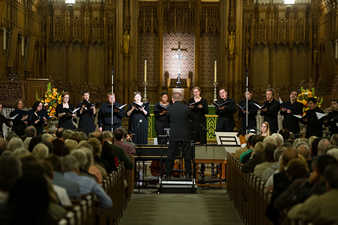A resourceful use of networking is important to the music director of a community symphony orchestra. Thomas Joiner is a master of that art, and the Hendersonville Symphony Orchestra benefits through the high quality of guest artists that accept his invitations to perform with the HSO. Joiner’s faculty position at Furman University and especially his 29 years of affiliation with the Brevard Music Center put him in contact with some remarkable musicians, and Stanford Olsen is one.
Now a professor at Florida State University, Olsen is a lyric tenor with two specialties. During the first half of the program, Olsen the oratorio singer was heard. After intermission, Olsen the bel canto operatic tenor held center stage. The adjustment of vocal detail, the “shifting of gears” between the two halves of the program, was striking.
After an orchestral opening piece (Ravel’s Mother Goose Suite, with its extensive use of orchestral soloists) came the oratorios. Above a continuo provided by organ, cello and bassoon, Olsen sang the “Benedictus” from J.S. Bach’s Mass in B minor, while Joiner played the violin obbligato. A slender orchestra (oboes, bassoon, 23 strings, and organ) under Joiner’s direction then accompanied the “Deposuit potentes” from Bach’s Magnificat. The full orchestra rejoined the stage for three selections from Handel’s Messiah: the overture, the recitative “Comfort Ye,” and the aria “Ev’ry Valley.” Unlike many oratorio singers, Olsen sang without music. He has sung 142 Messiahs in his career, and the music is so much a part of his being that he spends time contemplating the Biblical text as he performs. His insight and reverence showed in his nuanced performance.
Olsen’s breath control seemed effortless, his vibrato appropriately narrow for the baroque repertoire, and his power exceptional. Long crescendos offered dramatic heights. I particularly admired “Deposuit potentes,” but all four selections shone. The orchestra, whose seating arrangement in First Baptist Church sometimes leads to balance problems (the cellos and the first violins are on the carpeted floor and the other players are raised), managed to provide a well-balanced sound.
Following intermission, the first movement of Mozart’s Flute Concerto, K.314, was performed by 17-year-old Josianne Bailey, winner of the HSO’s 12th annual Young Artist Competition. Her tone was continually pleasing. Her articulation, especially in staccato passages, was outstanding. Her intonation was very good, with the exception of a rapid passage at the end of the cadenza. Some of the rapid ornaments were blurred, possibly through a touch of nerves. Her concept of the piece was consistent and musical, her dynamics thoughtful. Altogether this was a performance at a professional level.
Then Olsen the bel canto singer took the stage. A quarter century ago, he was “covering” (standing by to substitute) at the Metropolitan Opera when the tenor in I Puritani became ill. At age 26, he debuted opposite Joan Sutherland to acclaim that launched a 13-year career at the Met singing primarily Rossini, Bellini, and Donizetti roles.
Donizetti’s melodramatic Lucia di Lammermoor and comic Elixir of Love provided three arias eminently suited to Olsen’s voice. Using a wider and I thought slightly more rapid vibrato, he invoked a “sob” quality for the melodrama and ringing high notes for the comedy. Throughout this repertoire, he seemed to have tamed high overtones that gave his voice a timbre quite different from his oratorio singing. A coloratura quality was apparent. In the comic arias, he used hand gestures and facial expressions to good effect.
The final grouping was by Rossini: the well-known Overture to Barber of Seville and the aria “Ecco ridente” from the same opera. Apparently inspired by listening to Olsen’s bel canto style, the Hendersonville Symphony Orchestra went into its own bel canto mode with an agility and lush tone that went well beyond Rossini’s printed page. The overture was performed at the highest musical level that I have ever experienced from this orchestra.
Stanford Olsen had been generous in his programming, perhaps too much so, and showed a little weariness in the fast passages toward the end of his final aria. But the letdown was momentary and could never erase the wonderful memories of hearing this fine tenor in one day in both of his chosen incarnations, as a reverent singer of oratorios and an exciting singer of emotional bel canto. Bravo!











